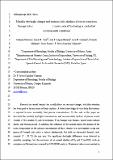Please use this identifier to cite or link to this item:
http://hdl.handle.net/10261/46479Share/Export:
 SHARE SHARE
 CORE
BASE CORE
BASE
|
|
| Visualizar otros formatos: MARC | Dublin Core | RDF | ORE | MODS | METS | DIDL | DATACITE | |

| Title: | Monthly day/night changes and seasonal daily rhythms of sexual steroids in Senegal sole (Solea senegalensis) under natural fluctuating or controlled environmental conditions |
Authors: | Oliveira, Catarina R.; Vera, Luisa María; López-Olmeda, José Fernando; Guzmán, José M. CSIC; Mañanós, Evaristo L. CSIC ORCID; Ramos, Jesús CSIC; Sánchez-Vázquez, F. J. | Keywords: | Sexual steroids 17β-Estradiol Testosterone Day/night concentrations Annual rhythms Seasonal daily rhythms Temperatures Solea senegalensis female |
Issue Date: | Feb-2009 | Publisher: | Elsevier | Citation: | Comparative biochemistry and physiology, Part A, Molecular & integrative physiology 152(2):168-175 (2009) | Abstract: | In this paper we attempted to investigate the existence of daily fluctuations on plasma sexual steroids (17beta-estradiol, E2 and testosterone, T) in Senegal sole (Solea senegalensis) females. We described the monthly day/night concentrations and seasonal daily rhythms in animals reared under natural photo- and thermo-period. In addition, the influence of the natural annual fluctuation of the water temperature on the plasma concentration of these steroids was investigated, using one group of Senegal sole under a natural photoperiod, but with an attenuated thermal cycle (around 17-20 °C) for one year. Although no significant day/night differences were detected in monthly samplings, the existence of an annual rhythm of E2 and T (p < 0.01) with an acrophase in February was revealed by COSINOR analysis. Maximum values were reached in March for both steroids (6.1 ± 1.7 ng mL- 1 at mid-dark, MD and 4.0 ± 0.6 ng mL- 1 at mid-light, ML for E2 and 1.4 ± 0.4 ng mL- 1 at MD and 0.8 ± 0.1 ng mL- 1 at ML for T) in anticipation of the spawning season (May-June). As regards seasonal daily rhythms, the presence of daily oscillations was revealed. At the spring solstice (21st March) a daily rhythm was observed for both steroids (COSINOR, p < 0.01), with an acrophase at 20:00 h (E2) and at 21:08 h (T). In summer, autumn and winter no daily rhythms were observed due to the low steroid levels at those seasons. When Senegal sole females were submitted to an attenuated annual thermal cycle, the steroid rhythm disappeared (there was no surge in spring, as in the control group) and these fish did not spawn, despite being subjected to natural photoperiod conditions. This result underlined the importance of the natural annual fluctuation of water temperature and photoperiod on the synchronization of the spawning season and on the onset of steroidogenesis. | Description: | 20 p., 4 figuras y bibliografía | Publisher version (URL): | http://dx.doi.org/10.1016/j.cbpa.2008.09.012 | URI: | http://hdl.handle.net/10261/46479 | DOI: | 10.1016/j.cbpa.2008.09.012 | ISSN: | 1095-6433 | E-ISSN: | 1531-4332 |
| Appears in Collections: | (IATS) Artículos |
Files in This Item:
| File | Description | Size | Format | |
|---|---|---|---|---|
| Monthly daynight changes and seasonal daily rhythms.pdf | 379,5 kB | Adobe PDF |  View/Open |
CORE Recommender
SCOPUSTM
Citations
37
checked on Apr 18, 2024
WEB OF SCIENCETM
Citations
37
checked on Feb 28, 2024
Page view(s)
327
checked on Apr 23, 2024
Download(s)
294
checked on Apr 23, 2024
Google ScholarTM
Check
Altmetric
Altmetric
WARNING: Items in Digital.CSIC are protected by copyright, with all rights reserved, unless otherwise indicated.
